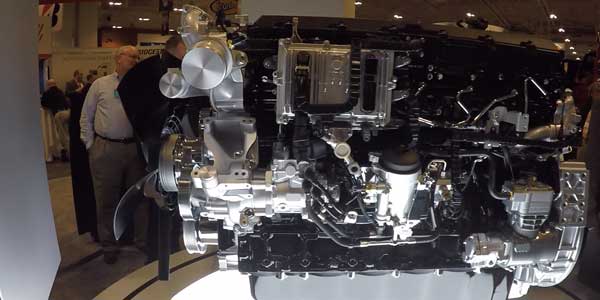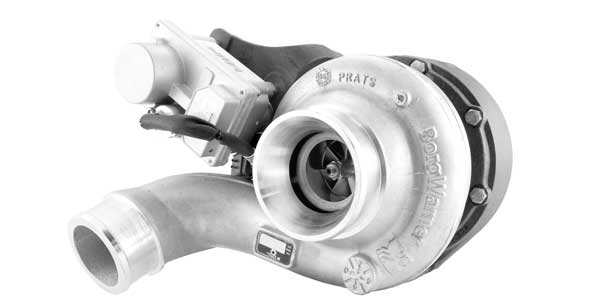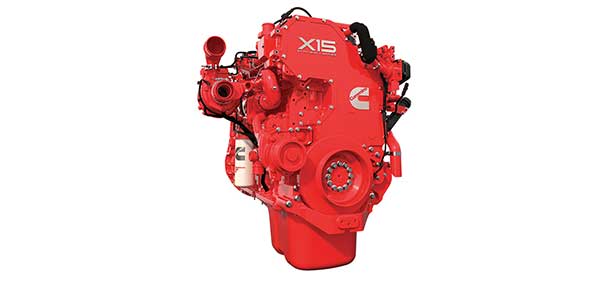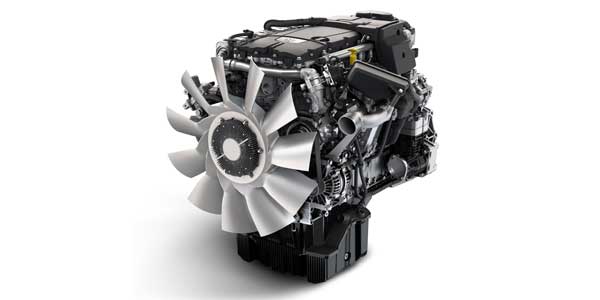An engine is a sum of its components. It’s a symphony of systems working together to produce power as efficiently as possible. Each engine OEM has its own strategy for achieving as much efficiency as possible. From turbochargers to waterpumps, no component is overlooked.
There are two most commonly spec’d types of turbochargers used in today’s diesel engine: Variable geometry turbos (VGT) and fixed geometry turbos. What’s the difference?
“A fixed geometry turbo has a fixed area/radius [A/R] that will give you one turbine flow parameter. Typically, fixed geometry turbos are sized to be a compromise between low RPM torque and high RPM power,” explained Seth Temple, senior application engineer for BorgWarner Turbo Systems. “A variable geometry turbo has vanes in the turbine stage that direct exhaust energy to the turbine wheel. Closing the vanes will a reduce the flow area, which improves response time [time to torque]. As the vanes are opened, more exhaust flow is allowed through the turbine stage. VGTs provide a broad power range, quicker response, ability to drive EGR [emissions control] and also to limit or control turbo speed.”
There’s a third, less common, turbo that you may also run into: waste-gate turbo.
“A waste-gate turbo is essentially the same as a fixed geometry turbo, but it uses an internal waste-gate [bypass valve] to regulate the exhaust energy driving the turbine wheel,” Temple explained. “Wastegated turbos typically have a smaller A/R turbine housing to improve low RPM response and then the waste-gate opens to control turbo speed, which controls boost pressure. Also, waste-gating will allow more mass flow through the turbine stage as the engine breathes more at higher engine RPMs. The downside of waste-gating is that exhaust energy is being wasted, bypassing the turbine wheel, so it’s not as efficient as a VGT.”
According to Temple, the major advantage of a fixed geometry turbo charger is a lower cost due to the lesser complexity compared to a VGT. A VGT, however, tends to be the most efficient of the three.
“Cummins first used a VGT design on a Cummins heavy-duty engine in 2002,” began Clint Garrett, Cummins X15 engine product manager. “This has helped supply higher boost pressures even at low engine speeds, in order to maximize performance. The Cummins VGT has fewer moving parts and only one moving component in the hot exhaust stream, which improves reliability and durability. Overall, variable geometry has helped to more efficiently use exhaust gas recirculation to reduce NOx levels. The VGT on the 2017 X15 has been enhanced to provide the same amount of pressures in a smaller package, offering fuel economy benefits without sacrificing reliability as we have also increased turbo actuation strength, four to six times over previous models.”
VGTs allow flexibility in fine-tuning turbine aspect ratios to efficiently match engine speeds allowing optimal boost at any speed, noted John Moore, product marketing manager of powertrain with Volvo Trucks North America. “We can also manipulate the geometry of the turbo to create exhaust backpressure, which serves a dual purpose of acting as an engine brake and a pressure source for more efficient EGR. Because of the robust construction of the VGT, there is no impact on maintenance.”
The recently announced International A26 12.4 liter engine also sports a VGT that reduces complexity and enhances reliability, the company explained.
“A variable geometry turbo provides more adjustability to be able to precisely tune the amount of boost pressure for all conditions,” said Jim Nachtman, Navistar’s product marketing manager for on-highway trucks, speaking to the use of VGTs in general. “A variable geometry turbo can enable increased engine braking horsepower as well. VGTs are typically maintenance free and are serviced as a complete assembly or electronic actuator only.”
Mack Trucks’ MP engines also employ VGTs. And if you’re starting to notice a trend here, you could probably guess that PACCAR’s MX series engines also use VGTs.
“Significant effort went into the design and validation of the VGT to ensure product reliability and reduced maintenance requirements,” Anthony Gansle, Peterbilt’s market segment manager for on-highway. “The use of variable geometry tailors airflow, enhances engine demand for requested output and enables excellent throttle response and efficiency over a wide operating range. The VGT on PACCAR engines is designed, tested and validated to be a maintenance-free component.”
Detroit, on the other hand, bucks the VGT trend by utilizing a proprietary asymmetric, fixed geometry turbocharger. This system is less complex than variable geometry turbo. And remember that part at the beginning of the story where we pointed out that the engine works as a whole to achieve its overall efficiency? Detroit’s in-house turbocharger design is optimally matched to the Detroit engine’s exhaust gas recirculation (EGR) system to meet its power demands and save fuel.
“We’re using variable exhaust cam phasing as one of our ways to help with aftertreatment management systems,” said Chris Moran, medium-duty engine group program manager for Daimler Trucks North America. “At the end of the day, it’s all about forcing as much air as you can into the combustion chamber to get the horsepower and torque that you want. For example, the new DD8 engine has a dual-stage turbo setup that will provider higher engine ratings, whereas some of the lower DD8 engine ratings will use just a single turbo. The DD5, in comparison, uses the dual-stage turbo all the time.”

















